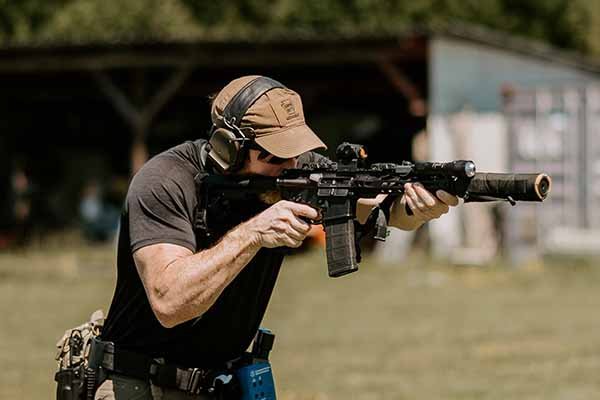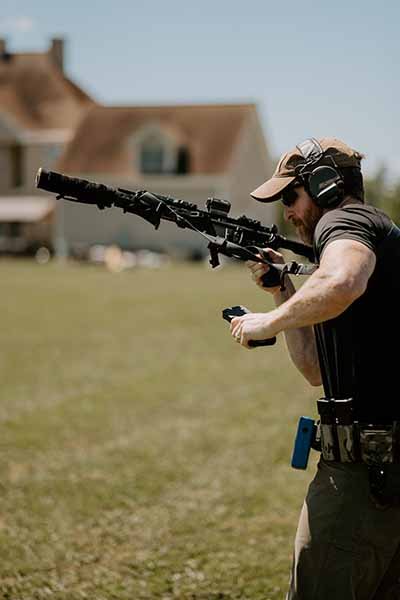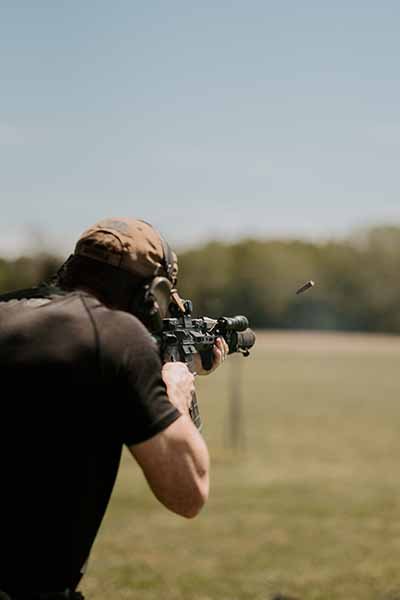Army Special Operation’s Jared Grant demonstrating how to properly shoot an AR15.
100 Rounds to Better Carbine
Written By Jared Grant
I love AR-15’s. Owning a well set-up carbine is like having one of the sports cars of the gun world. With that high performance car, the most fun you’ll probably have with it is on an open highway somewhere. I think the same principle applies with AR’s: bench rest shooting is well and good, but the real fun is bringing the gun to its respective “red line” and running it through comprehensive training.
We live in a unique time in gun ownership history. While previous generations were exposed to shooting disciplines by their parents, there are now more adults migrating to shooting ranges and instructive firearms classes who haven’t had that experience. We live in an age where information is abundant and easily accessible, but I still see lots of AR owners at the range who look like they aren’t quite sure what to do with it other than rip some rounds off with it and put it away.
A big challenge is the range environment itself. A lot of the famous tactical instructors that you’ll find on the internet have permissive private ranges that lend to shooting, moving and running all kinds of complex drills. While I aspire to own such a facility myself, I find my current range of choice restrictive. It’s restrictive in the sense that there is a requirement to stand on line with other shooters (no moving), and the closest target line is 50 yards (no 7 yard target burn down drills). Yet within this environment, over the last few years, I’ve become a markedly better carbine shooter.
Get the training you need with Jared and other world class instructors with Intuitive Self Protection. Click Below.
The Challenge
If I tell a fellow AR enthusiast at my local range to fire off approximately 100 rounds, and they crank off 3x magazines of 30, will they be better a better shooter? They most likely will not because there aren’t many skills being implemented into those mag dumps. So that is the challenge to be addressed here: If 100 rounds is a decent amount for a Saturday trip to the range, how can we build a skill set where we’re not just burning through that ammo and incorporating tactical elements to build proficiency?
Just like a fitness coach prescribes exercises, sets and reps, the same can be applied to your shooting regimen. Some things I encourage you to think about for your gear as you look at honing your carbine skills:
A timer is a great addition to personal equipment for tracking progress.
Timer: I resisted buying a timer for a long time, and you can run all of these drills without one. However, once you gut the 110 bucks and buy one, you’ll have a distinct edge by being able to track your progress. Like one of my senior scouts in Afghanistan used to say, “The numbers don’t lie.” I promise the first time you have it out at the range, you’ll forget the cost.
Steel Target: Again, not a cheap piece of gear. If you go to a range that has one, you’re blessed. I have a hanging USPSA C-zone that I cart out on my lane when I go. Shooting paper silhouettes is fine too, but the feedback of steel is invaluable.
As mentioned previously, 50 yards is the closest I can put my targets at the range I shoot at, so that’s where the steel goes. It’s a good distance to work at: far enough away that requires site discipline, but not so far that you can’t push a little speed. Without further delay, here are the sets.
Test Drive Our Training 100% FREE With ZERO Commitments
Set Breakdown:
Drills that incorporate reloads and weapons manipulation build confidence in weapons handling skills
First 10 Rounds: 1x round engagement (10 reps)
Standing at the high ready or low ready (do whatever you want to train/your range allows) on the buzzer (if you have it), shoulder carbine—disengage safety—fire 1x round—regain sight picture—safety on—back to high/low ready—repeat 9 more times. Why I like this drill: You’re training getting on target and building muscle memory reps for manipulating the safety. Most new shooters I work with can make their initial hits in 1.25-1.5 seconds. As their proficiency builds, engaging at under 1 second becomes achievable. If you can consistently get your first shot off in .75 seconds or less, that’s pretty quick.
Rounds 10-30: 1x1 (10 reps)
Same starting position, on the buzzer—shoot 1x round to bolt lock—reload—shoot 1x round. Safety on, reset the drill. Why: The best rifle shooters are masters of not just of shooting quickly, but manipulating their weapon systems. This drill gives you 10 good reps of getting on target, building muscle memory of where your reload magazine is, and working the bolt release on your weapon. Work on achieving an under 5 second par time for this drill, but don’t skimp on getting your follow up sight picture from the first shot. We’re trying to build overall good habits, not just race the clock.
Rounds 30-48: 2x1 (6 reps)
Same starting position, buzzer—shoot 2x rounds to bolt lock—reload—shoot 1x round. Reset and go again. Why: Most threat engagement drills call for attaining more than 1 hit on target. In the military we talk about shooting “controlled pairs” and then quickly assessing if the threat needs additional attention. Adding in the reload keeps shooters working the controls of their rifle and building that muscle memory with an additional engagement. Ideally for time, this drill should only be longer than the split of the second shot. So if you’re doing the 1x1 in 4 seconds, your goal is to maintain that pace while adding in a second shot split of ideally less than .3 seconds.
Multiple round engagements keep shooters focused on solid stance, trigger control and sight acquisition
Rounds 48-73: 2x3 (5 reps)
On the buzzer—shoot 2 rounds to bolt lock—reload—shoot 3x rounds. Why: This drill continues to keep shooters building that habit of controlled pairs, but adds multiple hits to the follow up reload. Sometimes on 1x1’s, shooters develop a bad habit of having sloppy hand placement on their follow up shot because they only have to make 1x hit. When its 3, it forces the shooter to regain solid hand placement and drive the gun back into the target.
Rounds 73-93: 3x2 (4 reps)
Buzzer—3x rounds to bolt lock—reload—2x additional rounds. Why: This one simulates a bit of an “Oh SH*&” scenario. Push hard to get those three rounds on target as quickly as possible- add speed until you start missing 1 of the 3 and then back it off. We’re trying to simulate putting hits on/suppressing a threat before they can do the same on us. If you have a timer, take note of your splits and see if you can shave some hundredths off of those first three.
Rounds 93-100 1x4x2 (1 rep)
Buzzer—1x round to bolt lock—reload—4x rounds to bolt lock—reload—2x rounds. Why: Partly to round out the 100, partly to mess with the brain housing unit and do something a little different. Fight through the multiple mag changes and different round count per reload: I guarantee something will happen within this drill that will cause a little friction whether its equipment or user induced.
Like with any skill, building firearm competence should incorporate a multifaceted approach. Dry fire, professional instruction, and testing of personal equipment are some of the foundational elements that make well rounded shooters. Using drills like the ones listed above can help transform a casual Saturday of punching paper into a honed approach in overall proficiency.
Get the training you need with Jared and other world class instructors with Intuitive Self Protection. Click Below.
Summary
Make sure you practice with whatever weapon platform you own but most importantly, seek professional training to take your skills to a whole new level. A good instructor can and should take months or even years off your learning process. This gets you where you want to be much faster!!
The Workout
First 10 Rounds: 1x round engagement (10 reps)
Rounds 10-30: 1x1 (10 reps)
Rounds 30-48: 2x1 (6 reps)
Rounds 48-73: 2x3 (5 reps)
Rounds 73-93: 3x2 (4 reps)
Rounds 93-100 1x4x2 (1 rep)
Jared has been serving on active duty for the past 11 years and is currently in Army Special Operations. His 6x combat deployments include Afghanistan, Iraq/Syria and AFRICOM. He is an avid hunter and competitive shooter, and has trained with the ISP team on multiple occasions to share his experiences and build his own skills for the everyday mindset.





